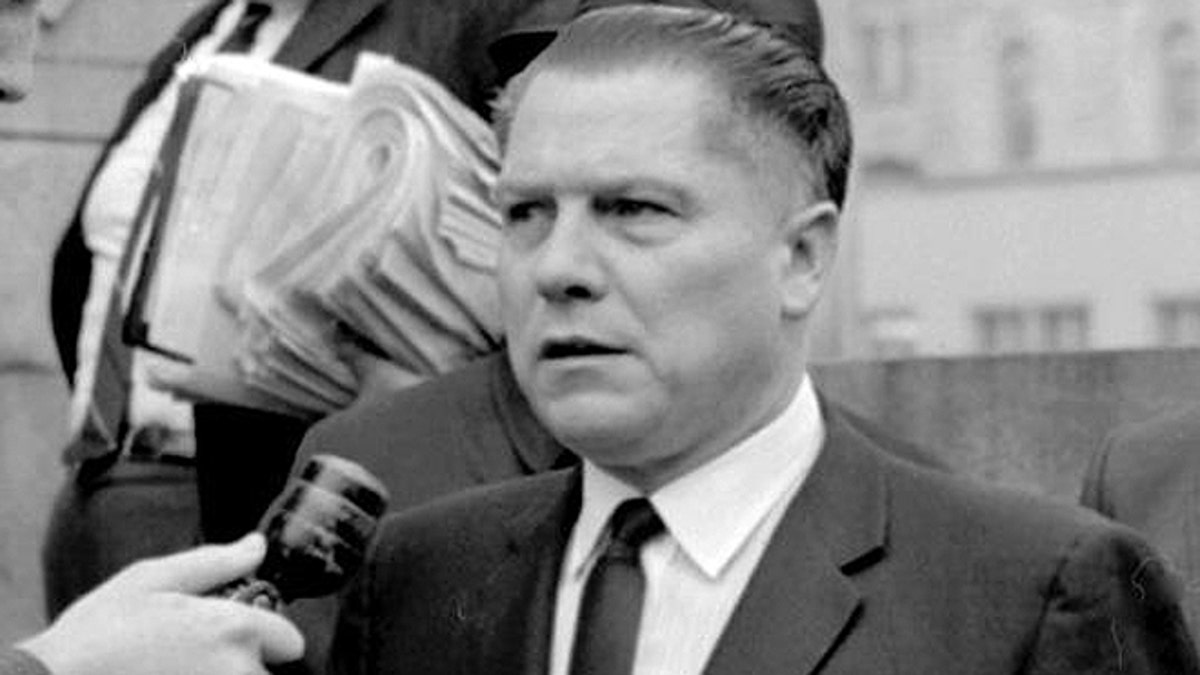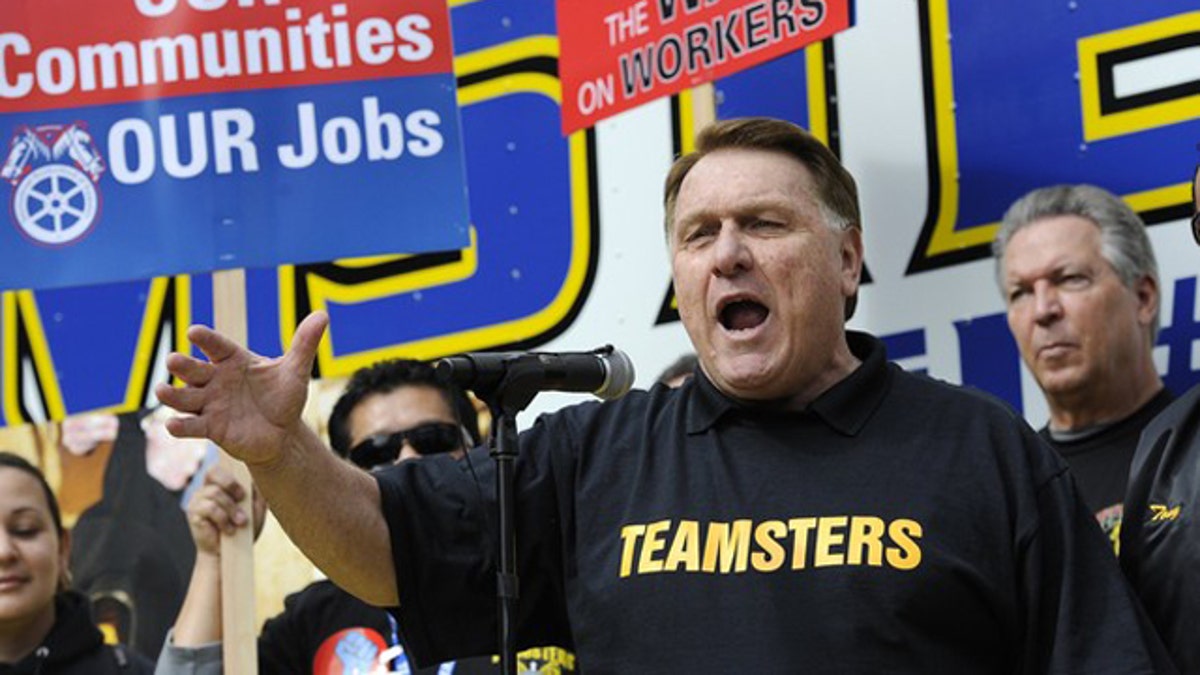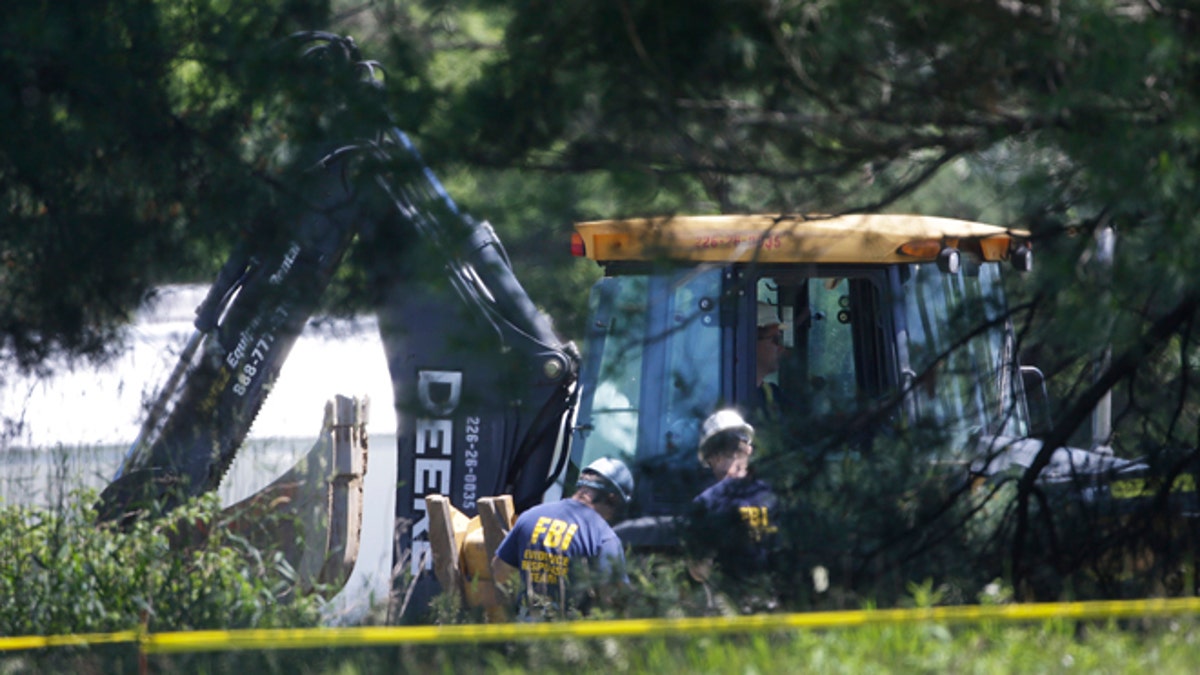Eric Shawn: Release the Hoffa FBI files -- now
Learn more about Jimmy Hoffa, Frank 'the Irishman' Sheeran and the discovery of blood evidence in the FOX Nation special 'Riddle: The Search for James R. Hoffa.'
The nation's most notorious missing person's case, the disappearance of Teamsters Labor leader Jimmy Hoffa in 1975, can be solved by the stroke of a pen.
The U.S. government should order the immediate release – un-redacted and in full – of the FBI's secret files that the bureau has compiled on the Hoffa's case, and also order the re-testing of the blood evidence that Fox News found on the floorboards of the Detroit house where a major suspect told me that he murdered Hoffa. The FBI informant interviews, known as 302's, and other documents such surveillance reports and wiretap transcripts have been blocked by the bureau from complete public release for decades.
"I don't see any reason to keep it secret," says Keith Corbett, the former chief of the organized crime section at the U.S. Attorney's Office in Detroit, who was the top federal prosecutor in charge of the Hoffa case for years. "Investigative efforts are paid for by the taxpayers, and if there is no threat to somebody, I would be in favor of dispersing the information."
Even a former United States Attorney General, who as a federal judge presided over mob cases among others, is calling for transparency.
"There is no harm to law enforcement from releasing it, and there has been substantial public interest in this case for decades," declares Michael Mukasey, who served as Attorney General under President George W. Bush.
"Unless someone in law enforcement can say, with a straight face and back it up with facts that this is an active investigation that could result in bringing a prosecution, the information should be released."
Those who have investigated the case for years are demanding the same.
"The FBI files on the disappearance of Jimmy Hoffa should be released," said former Detroit Free Press Pulitzer Prize-winning reporter David Ashenfelter, who reported on the case for decades.
"Virtually all of the key players in Hoffa’s disappearance have died and for the FBI to presume that the case will ever result in an arrest is far-fetched. It’s time for the files – unredacted files – to be released so the public can find out what the FBI knew and when it knew it."
Dan Moldea, a Washington journalist and long-time Hoffa investigator, said full disclosure is key. He wrote the landmark book, "The Hoffa Wars, Teamsters, Rebels, Politicians and the Mob," in 1978 and even interviewed the main suspects.
"Without full disclosure, you have the conspiracy theories," Moldea said.
The bureau was sued and released about 17,000 Hoffa case documents almost 30 years ago, but Moldea said that the government redacted, or blacked out, the vast majority – about 12,000 of them. He said there is no longer any valid reason for the government to hide anything.
"We have a famous American...who vanished from a public place in broad daylight. We need to know what happened. This cannot happen in America," Moldea insists.
It was a hot afternoon on July 30th, 1975, nearly 92 degrees, when the labor icon is said to have opened the door of a 1975 maroon Mercury in the parking lot of the Machus Red Fox restaurant, in Bloomfield Hills, Michigan, and climbed in. It is believed that Hoffa thought he was going to a sit-down with Detroit Mob Boss Anthony "Tony Jack" Giacalone and reputed New Jersey mobster and Teamster Anthony "Tony Pro" Provenzano, to settle along-standing dispute with "Tony Pro" and discuss Hoffa’s efforts to regain the union presidency.
He was never seen again.
One of the FBI's suspects in the disappearance, Frank Sheeran, was then a 43-year-old Delaware Teamsters president and admitted mob hitman for Pennsylvania’s Bufalino crime family, who took the Fifth when called before the grand jury probing the case in Detroit. His crime family was said to be close to New York's Genovese family, in which “Tony Pro” had long been identified as a powerful capo.
In the spring of 2001, an 80-year-old Sheeran opened up to me.
I met Frank to start preparing an in-depth investigation, interview and news story about his claims. He was accompanied by his former lawyer, Charles Brandt, the author of Frank's then-proposed biography. Brandt had been able to spring Frank from a mafia-related federal racketeering prison sentence, and for that reason he was taken into Frank's confidence.
Frank, over a period of years, slowly confessed to Brandt that he was in on the plot to kill Hoffa and that he, in fact, pulled the trigger. The basis of his claims became Brandt’s best-selling book, "I Heard You Paint Houses, Frank ‘The Irishman’ Sheeran and Closing the Case on Jimmy Hoffa," as well as my Fox News reporting and current Fox Nation news special, "Riddle: The Search for James R. Hoffa."
"Frank shoots him twice behind the right ear," said Charlie. "The blood pattern matches where the body went."

Francis Joseph "Frank" Sheeran, a Delaware labor leader and mob associated known as "The Irishman," told Fox News Channel's Eric Shawn he pumped two bullets into the back of Hoffa's head in a Detroit-area house. (Courtesy: Chip Fleischer, Steerforth Press)
At our meeting, I asked Frank for the directions to the house where he says he shot Hoffa. He rattled off the route from the nearby restaurant to the house, and described its interior layout to a tee.
Three years after our meeting, in 2004, I went to that house on Beaverland Street in Detroit with Fox News producer Ed Barnes. We took up the linoleum tiles that had been placed over the hardwood floor in front foyer and hallway, and hired a forensic team of retired Michigan state police investigators to try to find any blood evidence. They sprayed the chemical luminol on the floors, which homicide detectives routinely use to discover the presence of blood.
We found it.
The testing revealed a specific pattern of potential blood evidence, laid out like a map of clues to the nation's most infamous unsolved murder. Little yellow numbered tags were placed throughout foyer and hallway floor, to mark each spot where the testing yielded positive results.
"What you found is all that's left of the body of Jimmy Hoffa," Brandt told us. "It is the indications of blood, in a pattern that fits exactly what Sheeran described happened in that house. You found a pattern, that fits perfectly, fits perfectly, what Sheeran had told you. Fox News had the answers. The FBI would not have known the location of that house."
The greatest amount of positive hits was found right next to the front closet door, where Sheeran said Hoffa's bleeding head hit the floor. Seven more tags lined the narrow hallway toward the rear kitchen, marking the spots that perfectly mimic Frank's story of Hoffa's lifeless body being dragged to the kitchen by two waiting accomplices, who then stuffed him into a body bag and carried Hoffa out the back door to be cremated.
The FBI tested the floorboards at its lab in Quantico, Va., and said that of 50 specimens recovered; 28 tested positive for the possible presence of blood. DNA was only able to be extracted from two of those samples. One blood drop was "of male origin," and the other was deemed "largely inconclusive."

Labor leader Jimmy Hoffa, who was 62 at the time, disappeared in July 1975. He was declared legally dead in 1982. (AP)
It is time to retest that blood evidence again, using the latest DNA technology not available 16 years ago.
In addition, there have long been reports that informants knew how the hit went down. It is past time to reveal who those credible informants fingered.
The conventional wisdom for years was that Hoffa was murdered on orders of the mafia because he wanted to regain the Teamsters' presidency. Prosecutors have long pointed to various mob suspects, such as Sheeran and his boss, Russell Bufalino, one-time head of the Bufalino crime family, as well as Giacalone and “Tony Pro.”
The FBI's landmark HOFFEX memo, written in January of 1976, six months after Hoffa disappeared, names 12 suspects. Sheeran is one of them.
The last two major surviving suspects who are on that FBI list are Charles "Chuckie" O'Brien and Thomas Andretta.
The FBI report described O'Brien as being "raised by the Hoffa family, and brought into the Teamsters by JRH" (James Riddle Hoffa.) It said O'Brien was "well known by Teamsters officials and Detroit La Cosa Nostra," and that "he is known as a habitual liar," and "a pathological liar who borders on being totally incompetent."

When James P. Hoffa (above) first ran for the presidency of the Teamsters in 1995, he had no doubt about who was responsible. "I believe the mob killed my father. The mob will never come back in the Teamsters Union as long as I'm around," he declared. (Reuters)
The FBI said O'Brien was near the restaurant on the day Hoffa disappeared and an eyewitness identified him sitting in a car similar to the one that Hoffa allegedly got into. The FBI also said "it is possible he had no prior knowledge of an abduction when he picked JRH (James Riddle Hoffa) up, but certainly has detailed knowledge of later events."
O'Brien, who called himself a "foster son" of the Hoffas, was, at least until the day Hoffa disappeared, very close to Hoffa and his family.
"The only thing I say about Charles O'Brien is, we were so close at one time, we grew up together, and the fact that he never came to me and looked at me and said, 'how can you think that I did that?' He has not spoken to me," Hoffa's daughter, former Judge Barbara Crancer, said of O'Brien in 1995.
Crancer's brother, James P. Hoffa, who currently sits behind his father's old desk in Washington, D.C. as president of the International Brotherhood of Teamsters, echoed that sentiment.
"You can only hope that someday he will come forth and tell what he knows about the disappearance. I have not talked to Chuckie O'Brien since that day and I don't intend to ever talk to him," Hoffa bluntly said.
At a 2001 news conference Hoffa clearly harbored his own suspicions about O'Brien stemming from the day his father vanished.

Members of an FBI evidence response team look over an area being cleared in Oakland Township, Mich., Tuesday, June 18, 2013 where officials continue the search for the remains of Teamsters union president Jimmy Hoffa, who disappeared from a Detroit-area restaurant in 1975. (AP Photo/Carlos Osorio)
"His actions were so suspicious on this day. He couldn't account for where he was on this important day. Obviously, it brought suspicions on him, this on the very day my father disappeared or the next day, and I had a major confrontation to him to say, “Where were you? And explain yourself, and his reaction was to run out of the room and I haven't seen him since."
When questioned by the FBI, the HOFFEX report indicates that O'Brien changed the timeline of his activities on the day Hoffa disappeared six times. Like the other named suspects, he also took the Fifth before the Detroit Grand Jury.
"I have a very hard time thinking that he knew anything about it," his former lawyer, James Burdick, told Fox News. "He was not that bright guy and his story never changed."
O'Brien has refuted any allegations that he was involved. He is now in his 80's and living in a gated community in Florida. He was interviewed by the Associated Press in 2006 and said that he played no part in the disappearance.
O'Brien "adamantly denies having any role in whatever happened to Hoffa or knowing anyone who did. He keeps a photograph on his desk of Hoffa and his wife during one of their visits to Florida in the early 1970s.
“It’s very frustrating. I have so much inside, my love for him and his family,' O’Brien said. 'How long can you keep talking to people and being honest with people?'”
Sources close to O'Brien told Fox News that he does not want to comment about the case to us now.

Jimmy Hoffa, shown here in speaking to Robert F. Kennedy, was one of the most powerful men in America when he disappeared. (Courtesy: Chip Fleischer, Steerforth Press)
Thomas Andretta and his brother Stephen, who reportedly died of cancer in 2000, were also named by the FBI as suspects. Both were New Jersey Teamsters and reputed Genovese crime family mob associates. The FBI called Thomas Andretta a "trusted associate of 'Tony Pro,' reported by Newark source to be involved in the actual disappearance of JRH."
Andretta, who is now 80 years old and living in Las Vegas, served federal prison time for racketeering. He did not respond to Fox News' request for comment.
Another suspect, Genovese crime family hit-man and business agent for Provenzano's New Jersey Teamsters Local 560, Sal Briguglio, was shot to death on Mulberry Street in New York City's Little Italy in 1978, three years after Hoffa vanished. The FBI reports say a witness saw him at the Machus Red Fox restaurant on the day Hoffa disappeared.
"Briguglio was cooperating with the FBI to nail Provenzano," Ashenfelter said. His murder was never solved.
Another reported FBI source was New Jersey inmate Ralph Picardo, who was serving time for the murder of a loan-shark in 1975. The FBI said that Picardo started informing about what happened to Hoffa just over three months after he vanished.
Picardo told agents that Provenzano hatched two previous plots to kill Hoffa, and that a few days after Hoffa disappeared, Stephen Andretta visited him in prison and told him that "Provenzano's group was involved."
"Steve apparently starts giving things up. So, Picardo eventually decides, what am I doing? I have some great information here, and I'm going to use this to get my ass out of jail," Moldea said.
Moldea interviewed the group of suspects in October 1976 in New Jersey. He talked with Sal Briguglio, Thomas and Steve Andretta and Salvatore "Tony Pro" Provenzano. He said that both Briguglio and the Andretta brothers denied being involved in the murder.
"I think Sal Briguglio is the killer," said Moldea, though he does believe Sheeran was involved in the plot.
Brandt, who insists Sheeran was telling the truth, is demanding release of what he says is a much more recent FBI report.

James R. Hoffa (left) with his son, James P. Hoffa, at a testimonial dinner in 1965. (Library of Congress)
"I think we want all 302's of the FBI's debriefing of former Bufalino Family boss "Big" Billy D'Elia, who had become a cooperating FBI witness," he said. "The first question Detroit FBI agent Andy Sluss asked D'Elia, was what happened to Hoffa. D'Elia told Sluss to read (my) book."
Brandt also said FBI surveillance tapes and reports of Sheeran meeting about the murder with his fellow mobsters in a New York Italian restaurant right after Hoffa's disappearance should be made public as well.
D'Elia has not responded to multiple attempts by Fox News for comment on the case.
The Detroit FBI would not comment about Mr. Brandt's assertions.
Law enforcement sources do confirm that while we were conducting our investigation in 2004 in Detroit, the FBI tried to find the house even before we aired our first story.
"There's nobody to charge now with the murder because Sheeran's dead," said former Fox News producer Ed Barnes, who investigated the case with me in 2004. He also said it is time that the Hoffa information is released.
"It should be public. It was the biggest murder case that the United States had ever run across, and of one of its most important men. This was a direct challenge to the federal government” he notes. “This was, 'screw you, we can kill one of the most important men in the United States and get away with it.' And they did."
When James P. Hoffa first ran for the presidency of the Teamsters in 1995, he had no doubt about who was responsible.
"I believe the mob killed my father. The mob will never come back in the Teamsters Union as long as I'm around," he declared.
As for the possibility of releasing the Hoffa files, the FBI directed Fox News to file a Freedom of Information Act request and had "no comment" on the possibility of retesting the blood evidence that we found in the house.
In 1990 and 2000, The Detroit Free Press filed Freedom of Information Act lawsuits for the files. The result was the release in 2002 of the heavily redacted material that remains to this day the only glimpse available to the public.
In 1989, Hoffa's son and his daughter filed their own FOIA lawsuit against the Justice Department seeking the files. In response, prosecutors said public release of the material would harm the case and endanger informants.
But former investigators tell Fox News that now most, if not all, of the informants are presumed dead and the remaining two living suspects have already been publicly named in the FBI HOFFEX memo, and elsewhere.
"Release the files, test the blood. I want to see this case end. This case has to be solved," said Moldea.
Watch "Riddle: The Search for James R. Hoffa" on Fox Nation
Listen to the 8-part series: "Riddle: The Podcast,” behind the scenes conversations with those involved in our investigation.






















